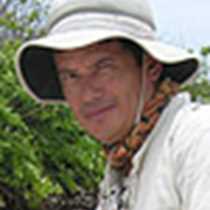Santa Cruz Island
Even though Santa Cruz has the largest town in the Galápagos, our guests were happy to visit this island because it is the place where they can see giant tortoises in the wild.
We began our activities at 8 AM landing at Puerto Ayora to visit the Charles Darwin Research Station. We walked along the path that connected the entrance with the giant tortoises’ corrals. Along this path, we observed as all the vegetation was turning green with the first rainfalls, and heard the land birds warbling happily on the trees. A cactus finch fluttered, feeding on the pads of the cactus, while on land a group of lava lizards observed us curiously.
At the beginning it seemed as if it could rain, but all changed suddenly when the first sunbeams appeared, warming the humid environment. We visited the corral of the baby giant tortoises, observing how similar they are at that age. They are so small that it was impossible to determine their carapace appearance and the size they will acquire when they are adults.
The opposite occurred with the adults, especially with Lonesome George and Super Diego, the most famous giant tortoises. Their carapaces looked completely different when compared across corrals. Certainly they were magnificent because they were curious and posing for our cameras.
After the first visit, by bus we reached the highlands and the first adventure was crossing the lava tunnel. Inside, our guests could admire how active this island was when it had active volcanoes. We observed how calcium carbonate has covered all the walls of the tunnel and small stalactites formations.
In the afternoon, before lunch, we enjoyed being with other giant tortoises again, but this time in the wild. The highlands were warming, but it was not an impediment for our guests to discover the tortoises’ natural environment. Afterwards, we headed to our buses to visit another part of the island, higher than the first place. “Los Gemelos” or pit craters, were our last visit during this day. Walking through a small forest of “scalesia pedunculata” trees, our guests finally observed that magnificent formation of the two craters located on both sides of the road. We talked about the formation, imagining how it was when their magma chamber collapsed and what the differences are between the volcanoes in Santa Cruz compared with others without vegetation in the lowlands.
Finally we headed back to the town of Puerto Ayora where a group of our guests stayed a little bit more in this beautiful harbor, watching local people playing Ecuadorian volleyball (Ecuavoley). Finally at 6pm all came back to the National Geographic Islander, happy because today was another beautiful day in this paradise called Galápagos.




